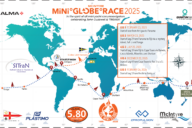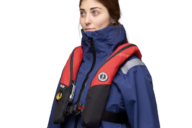With rough conditions during the first 24-hours of the 2015 Andrews Institute Pensacola a la Habana race, four boats retired. The home-made catamaran Surf Rider and the Island Packet 27 Island Sun returned to Pensacola Bay. Makani U’l, a Beneteau 40, suffered damage to her jib halyard and roller-furler system and is headed to St. Petersburg, Florida for repairs.Midnight Sun II, a Hunter 42, was dismasted at midnight and motored back to Pensacola Yacht Club.
Neil Davies, skipper of Midnight Sun II, said they had been sailing in 22-25 kts of wind through 5-7 foot seas. The highest wind they had seen was 30kts in gusts. “At Halloween midnight, the wind had just begun to drop off,” Davies said. “It was now blowing about 16 kts and the seas were settling. I was below and heard the ‘pop and crash’. The mast went over the port side and the boom landed on the arch over the cockpit. We think that the head stay broke at the mast-top, but we jettisoned the mast to protect the hull so we can’t confirm that. Thanks to the boom arch we were all unhurt.”
The Corsair 31R trimaran, Bellafonte, was the first overall to finish. Bellafonte led the Multihull Division out of Pensacola Bay on Saturday October 31st and completed the 511 nautical mile (nm) rhumb-line course on Wednesday morning November 4th. She finished after almost four days, and she actually sailed some 650nm tacking most of the way to Marina Hemingway.
Bene Vita— the second multihull to finish— has a 177 seconds-per-mile handicap in that division. Apparently she used her engine through the light air to help get to Cuba quicker. Engine use is allowed in this race, but incurs a stiff handicap-based penalty… adjusting the handicap time allowance by a correction factor and by the amount of time the engine runs in gear.
The first monohull to finish was the scratch boat in that division, Lesson #1 a J130 from New Orleans, LA sailed by co-skippers Guy Williams and Mike Finn and their crew of Troy Gilbert, Morgan Mayberry, Anthony Bartlett, Bryan Whited, Randall Richmond, and Claire Miller. Despite a broken alternator and a blown out mainsail (repaired and nicknamed ‘frankensail’), they finished as the first monohull. Lesson #1 did not use her engine except to charge her battery… until the alternator went out and there was no need. They charged with a solar panel from there.
Libra, a Tripp 57 from Orange Beach, AL, was the second monohull. She followed 15 minutes behind Lesson #1. With that finish time, Libra would normally beat Lesson #1 by many hours on corrected time, but apparently, like the cat Bene Vita, she used her engine for propulsion and will have to accept a penalty.
Several of the boats that have finished— and many still on the course— have used their engines for propulsion. Calculating the adjusted corrected times of all the boats will be complex.
More information is available at http://www.cubarace2015.com












